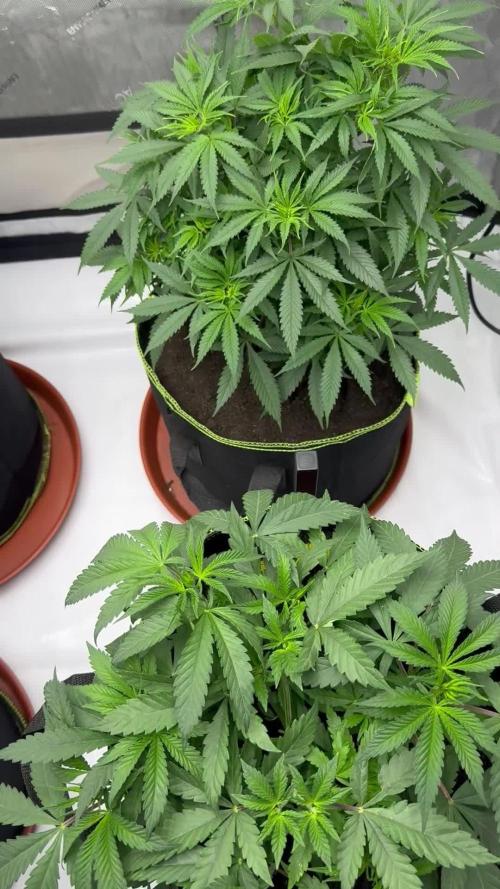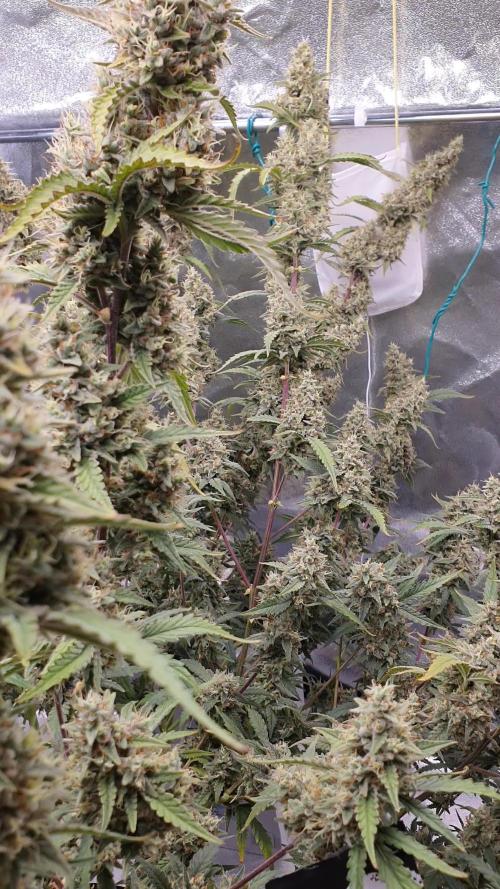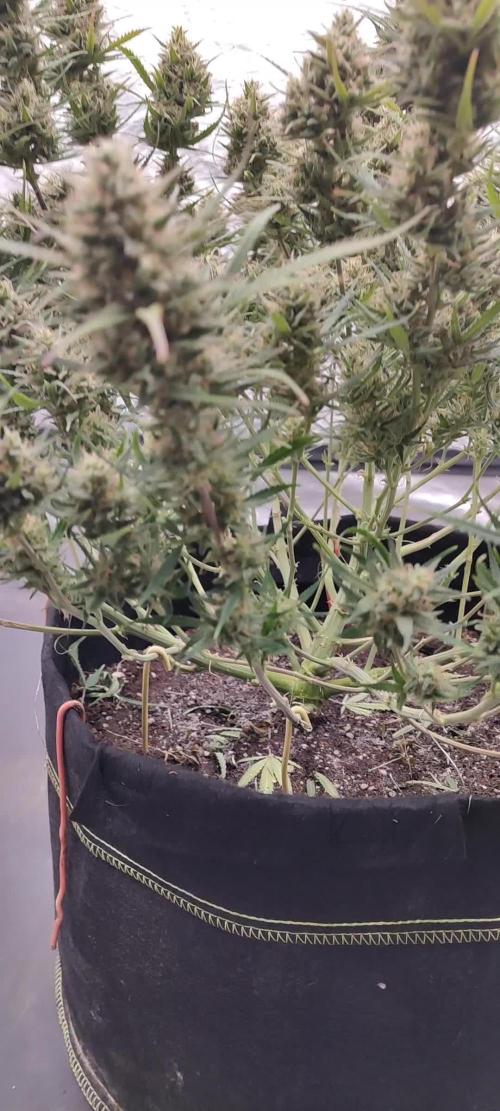The Grow Awards 2026 🏆 



























Likes
2
Share


@Islandgrowbro
Follow
Plants moved to final growing area. Lights added. Ground cover to be added. Spraying done to help fight fungus, insects and some nutrient application.
Likes
1
Share


@Greenzfingerz
Follow
These aint stardawg just been told my guy had two types of cuttings stardawg and gorilla skittlz ovs not dawg as its got destinctive smells etc defo more fruity smelling. Pissed off alittle but wots dones done doing ok been away for week so had someone check on em etc
Likes
5
Share


@BettaN
Follow
"What you get for a bag seed" week
- I've stopped using the Nitrogen reach nutrient. Bloomax is 1.7:14:14.5 NPK, by the leaves it seems like they have a slight nutrient burn, so it feels right to reduce nutrients.
- I've done some really low stress training on PE, just opened a light space for lower buds
And...............
- 'I think I saw a pollen sac', indeed suddenly something green appeared on the top part one of BD's biggest colas.... I've decided to use tweezers and get it out
- Now I imagine hermis everywhere, I've read about them a bit, mainly looking for images.... Something about PE doesn't feel right.
Just spoke to friend and he also thinks PE has many pollen sacs. I'm going to try to save it - problem is I can only see the bastards when I take a picture with extra zoom... at least she's not huge.
I guess BD is pollenated by now.... will update.....
EDIT: I've transferred PE outside, week 6 of flowering starts today, so I think I'll harvest her in 10 days. She originated in a bag seed, so I'm taking it easy, learning a lot!!!!
My first grow is kind of a rehearsal - the feminized seeds arrived couple of weeks ago and I hope to start a new diary soon :)
Likes
10
Share


@Aleks555
Follow
Всем привет. Неделя прошла без происшествий, хорошо растет, мы ветки нагнули
Likes
17
Share


@420DeepGrow
Follow
📆 Semana 6
La Slapz ha empezado a sacar su carácter esta semana.
Los cogollos se están formando con mucha fuerza y empiezan a tener ese aspecto compacto y agresivo tan típico de esta genética. La resina va cubriendo con rapidez las flores y las hojas cercanas, dándole un look pegajoso y potente.
En cuanto a la nutrición, sigo con XpertNutrients y el añadido de Sticky Fingers, que ya se está notando claramente: los tricomas están explotando y el perfil aromático empieza a intensificarse, con ese fondo gaseoso y dulce que caracteriza a esta variedad.
Los Adlite siguen haciendo su trabajo impecablemente, y se nota sobre todo en cómo la Slapz está sacando cogollos consistentes hasta en zonas más bajas, aprovechando toda la estructura.
El entorno se mantiene estable, con temperaturas entre 22 y 25 °C y una humedad del 55%, controlada gracias a una buena circulación de aire. De momento, ningún síntoma de estrés o problema relacionado con hongos.
Aromáticamente, empieza a destacar por esa mezcla entre lo funky y lo afrutado, con un golpe potente que se anticipa a lo que puede venir en las próximas semanas.
Una planta que promete pegar fuerte, como su nombre indica.
¡Seguimos creciendo fuerte! 💪
Likes
Comments
Share


@Gardens_of_Of
Follow
They seem to like their new 5 gallon pots and they are growing vigorously. Especially, Blueberry Muffin is begging to switch to flowering.
I top dressed them with worm humus and 50 Gr of BioBloom end of the week. Using the worm humus for the first time, so I am curious about the results.
Giving them another 5-7 Days before switching flowering to make sure that I make the most out of the space.
Likes
59
Share


@TheCannaProphet
Follow
~ AirCube Active Oxygen Ebb/Flow System sponsored by GrowAce, featuring Tropicana Cookies by FastBuds ~
Well guy's and gal's here we go again on another exciting Autoflower run together! This time will be different as I will be doing a 'Hydroponic' run utilizing the AirCube Active Oxygen Ebb/Flow System by GrowAce, who were kind enough to sponsor me for this run, so it should be interesting to see what results I get and have some fun along the way!
•Let me first tell you about this 6 Pot Ebb/Flow system from GrowAce:
"The AirCube system is the one and only Ebb & Flow grow system on the market that combines the benefits of air pruning with a fully automated Ebb+Flow system! With the AirCube's proprietary fabric pot in bucket design, this system is guaranteed to outgrow any other Ebb + Flow system on the market. The results speak for themselves- grow MASSIVE roots that result in MASSIVE fruits!
Air Pruning- Air Pruning only happens with fabric pots. As the roots reach the fabric walls of the pot, they penetrate and grow into the breathable fabric. Once penetrated, the roots are exposed to air, which causes the tips of the root to dehydrate and naturally prune themselves. This natural pruning process forces the roots to grow tons of lateral fibrous feeder roots. This results in a plant that utilizes the entire root zone and fills the entire pot with tons of roots. These fibrous feeder roots are incredibly effective in uptaking water and nutrients, resulting in a plant that grows healthier and more vigorously!
Oxygen Benefits- Without oxygen, nutrient absorption cannot occur. On a molecular level, oxygen is needed to transmit nutrients across the cell walls and into the roots of a plant. With the AirCube's proprietary bottom lifted draining design, the system actively draws all of the water out of the bucket pulls vital oxygen into the root zone.
Maximum Versatility with Any Grow Medium: The AirCube System is the only system on the market that allows you to use any growing medium you like. Use coco coir, soil, peat moss, perlite, vermiculite, hydroton, rockwool or any other medium you wish! This system is the most versatile Ebb and Flow bucket system in today's hydroponics industry.
Temperature Control- with the fabric pots constructed with highly porous polypropylene fabric, heat dissipates easily and effectively. Unlike standard plastic pots, heat isn't trapped in the root zone. Heat in standard plastic containers can reach temperatures of up to 125 degrees. When this type of heat is trapped and unable to escape, it can damage your plant's health and limit the potential of your harvest. Growing in the AirCube System, plant roots grow cooler, healthier, and more vigorous.
Largest Pots in its Class- this system features 5 Gallon grow buckets, the largest pot size of any other ebb and flow hydroponic system in the market.
Modular and Expandable- start with 6 grow buckets and expand up to 36 grow buckets with the optional 105 gallons PopTank reservoir!"
For my medium and nutrients I decided to also switch things up from my regular Organic runs, going with Plagron Nutrients and Root Royale 70/30 Coco/Perlite. When filling the fabric pots with medium, I first added just under a gallon of horticulture perlite from Nor-Cal as a base layer to ensure good drainage and then filled the remainder with the Root Royale.
•Now for the outstanding, award winning strain from my friends at FastBuds... Tropicana Cookies Auto:
I'll be running Tropicana Cookies Autoflower which is a 60/40 Indica/Sativa Hybrid. "Tropicana Cookies Auto is the perfect variety for growers of all levels, especially beginners as this strain performs very well outdoors and indoors, and can produce up to 500 gr/m2 in 56-63 days without needing extra maintenance. Reaching up to 110 cm, this strain grows fairly tall with medium-sized branching, showing its mixed heritage. Definitely the right choice for those with a high tolerance looking to get their hands on the strongest autoflowers out there. You can expect an extremely powerful and long-lasting high that’ll boost your mood and give you that extra push you need to start your days on the right foot. This variety offers the whole range of citrus and woody flavors with a strong candy-sweet background that will keep you coming back for more and more."*
*References: GrowAce.com, 2fast4buds.com
______________________________________________________________________________________________________________________________________________________________________________________________________________________________________________________________________________________________________________________________________
The Setup:
• AC Infinity 4x4 tent
•AC Infinity Cloudline T6 Exhaust Fan w/ Controller 67
•HLG 650R w/UVA Bar *** For some reason GD does NOT have a listing for the USA version of the 650R so I selected the closest match to it.
•AirCube Active Oxygen Ebb/Flow 6 pot System
•DL Wholesale Root Royale Coco Lite 70/30 coco/perlite
•TrolMaster Hydro-X Controller for light
•AutoPilot APC8200 co2 controller fed by a 50# tank
•16" Hurricane oscillating fan and 8" floor fan
•Tent cooling via filtered outside air delivered by AC Infinity Cloudline T6 fan
•BlueLab instruments: PH Pen and Truncheon Nutrient Meter
______________________________________________________________________________________________________________________________________________________________________________________________________________________________________________________________________________________________________________________________________
Weekly Updates:
11/19- Week 4 of flower is here and OMG, these Tropicana Cookies auto's from FastBuds are on🔥!
The #1 pheno is stacking away, and is going to have some large flowers! The #3, which along with the #1, has beautiful purple coloration in her flowers and albeit not as stacked as the #1, she's a stunner! The #2, which is missing the purple coloration, definitely wins for having the 'funk'. The #2's flowers are getting covered with trichomes and her aroma is super strong!🤪
11/21- All three continue to do well and are progressing through flower nicely. I'll be doing a drain/clean/refill on the AirCube reservoir tomorrow to give the girls a fresh dose of nutrients.
11/23- 🦃Happy Danksgiving Fam!😎💖
11/25- I'm continuing with running the AirCube reservoir for 5-6 days between drain/refill, only topping off with well water and checking.adjusting the PH. The beginning nutrient strength is 800ppm, and over the course of the 5-6 days it has only been dropping approx. 150ppm's.
The #2 pheno is getting super frosty, has a very fruity aroma, and is looking like a champ! The #1 and #3 plants are looking sexy as hell with their deep purple coloration and both have a earthy funk aroma to them!
Yesterday I raised the HLG 650R to it's maximum height available putting it approx. 26" above the #3's, which is the tallest of the three plants, canopy. In addition, I reduced the power to 80% to keep from bleaching out the top of her main cola.
There's eight weeks past now since these girls broke ground and they're coming into the final stretch with only a couple of weeks to go. I hope to see you next week where I'll be starting to try to figure out a 'flush' for the trio. 😎🙏💚
💚 Thank you for checking out my passion in life! Please visit as often as you wish and I hope you enjoy this journey as much as I know I will! Grow what you love, Love what you grow!💚
Likes
11
Share


@Chimney_Chief
Follow
Started noticing nute burn on the tips of my leaves this week which have slightly worsened since, I feel this may have been an oversight in adding DRAGON FORCE alittle earlier than recommended. Have corrected the nute regime this week and fingers crossed she perks up.
Buds are still growing pungent and sticky so no real major concerns.
Likes
13
Share


@RFarm21
Follow
Semana 8 abril - 14 abril
Algumas folhas estão um pouco vermelho-escuro , então aumentei as doses de bloom para corrigir a possível deficiência.
12 abril - feeding day (1.5L):
Calmag 1.2ml; bio bloom 4.25ml; topmax 4.25ml; bio heaven 5ml; alg-a-mic 4ml; acti-vera 5ml; bio grow 3.5ml pH 6.3
Likes
19
Share


@Master_weeda
Follow
Bonjour à tous les padawans et maîtres jedis
Jour98 arrosage avec 2 litres d'eau ph6.3
Jour101 arrosage avec 2, 5litres d'eau ph6.3
Jour103 arrosage avec 2 litres d'eau ph6.3
Likes
Comments
Share


@High_Grade_Dadli
Follow
Jus trying to make the best out of a bad situation....when is not pouring rain...got excessive heat warning but still gonna pull tru with something....girls are smelling lovely and got that sticky feel to dem leave you fingers wet jus by passing over...harvesting is the upcoming week jus to prevent any further damages.
Likes
8
Share


@Polyphemus
Follow
Seeing some initial plumping by FD 30 and even more in the current pictures.
BBxGS - going strong and similar to previous plants of this strain.
Grandpa's Stash - Loving the aromas. Except for 1 plant, definitely the fastest development rate so far
Banana Hammock - The primary cause of the massive stink throughout my house, I think. Also develioping quickly.
Overall, the plants are healthy. Some blemishes here or there. Had some trouble keeping up with RH, so I removed some leaves. I have been topping off the 3 hammocks and 2 bbxgs plants with plain water immediately following a fertigation. They were lookin too lush. I've done this 5-6 times over the last week and adding less than a 1/2 gallon to each. However, i think the night time temps dropping to 67-68F are the cause at this point and i am seeing purple creep into leaves not a toxicity.
Have had some minor tip paling on 1 of the hammocks for at least 7-10 days, but it never progressed. If i get some exotic colors in these as they progress, i don't think this is necessarily a nute-related issue at this point. I upped K ppm when i initially saw it, but only slightly. Think these plants are just on the dark side. Thinking these will have dark purple leaves like my Dinafem OG Cookies grow.
Even so, will continue to dilute just in case on the darker plants and cease doing that if i see a hint of deficiency.
While trichome production has been great from an early stage of flower, I've been a bit disappointed by it lately. The ethos plants seem to be lagging a bit, but also seeing it on stems and petioles. The bbxgs plants continue to cake it on. I don't smoke stems, petioles or leavs, so it isn't a major concern. All that matters is the aerial density of trichomes on the calyxes. I'm sure they'll be okay.
The smell is really intense for the last week. My house smells like it is harvest day, every day. Love it!
Climate pics added / update - You can see where dehum settings change at end of day. It can barely keep up when plants are trasnpiring. I had to remove leaves in order for it to maintain 50% during lights on. Temps are consistent as long as outside weather isn't unusually warm. Like I've said before, probably operating a bit too high in VPD, but concentration of fertilizer is reduced slightly and the VPD at the leaf, where it matters, is probably a bit lower than these readings. Probe is 6" under canopy and would be more accurate if placed in the middle of it.
Night time VPD used to be equal or even a bit higher before i started trackign this stuff. I've got that flipped back to normal, but no idea if that is a benefit or just my own OCD. According to what i've read, it shouldn't be more than .4 kPa below daytime VPD. At least that part has some research behind it as to why.
A week of tweaking behaviours and settings at specific points in time has lead to as consistent of an environment as i'm going to get relatiave to what i'm willing to invest (time/effort).
The night time graphs are an hour short because they are of the day of this update. Close enough for display purposes.
I will make a spreadsheet that will link to the exported date file of the probe at some point. For now the graphs in the app are good enough. I want to collect a lot more data in future. Start to figure out just how impactful some of this is or is not. Ambient weather outside, growth measured in multiple ways (height / number of nodes), incremental use of water/fertilizer electricity (already have a good guage of this) etc etc.. Gonna do a full statstilal analysis andn regression of various factors over time... come back in 10-20 years, LOL. Then again, may proclivity for laziness may be a factor too.
Likes
19
Share


@Skinnytalls420
Follow
Day 68-16/02/22 I’ve harvested 6 of the 25 so far they are drying some more to come down over the next days all buds looking juicy and crystals everywhere!!!
Likes
40
Share


@Kitties_and_Colas
Follow
~_~_~_~_~_~_~_~_~_~_~_~_~_~_~_~_~_~_~_~_~_~_~_~_~_~_~_~_~_~_~_~_~_~_~_~_~_~_~_~_~_~_~_~_~_~_~_~_~_~_~_~_~_~_~_~_~_~_~_~_~_~_~_~_~_~_~_~_~_~_~_~_~_~_~_~_~_~_~_~_~_~_~_
We planted 5 seeds, our goal is 2 plants of this strain for this 4x4 (all extra plants will live out in the 5x5)..we're using a brand new light for this grow, the Solux350 by Hortibloom! 💡🌱(https://hortibloom.com/products/solux-350-led-grow-light)...
This tiny fixture emits a ton of light for its size..we have 20 seedlings under her, hung at the recommended 24inches and at 25% power..I'm really excited to see what this light is capable of! Thanks for dropping by and happy harvests everyone!! ❤️💡🌱😽💨
⚡Hortibloom/Solux 350⚡
Specifications ⚙️:
Diodes: Samsung LM281 Pro / Osram DR (1,440 total)💡
Driver: Inventronics 350 watt🔌
PPF: 1015 μmol/s ☢️
PPE: 2.9 µmol/j 〰️〰️
Lifespan: 50k+ hrs ⌛
Weight: 14.3lbs lbs (6.5kg)
Veg Coverage: 5 x 5 ft 🌱
Flowering Coverage: 4 x 4 ft 🌼
-The Solux 350 uses an aluminum heatsink (no fan), quiet operation 👂⬇️
-IP65 waterproof ratings, tolerant to high humidity grow environments 💦 ..
-Many units may be daisy-chained via RJ14 and dimmed from a single controller 💡~💡~💡~💡~💡
~_~_~_~_~_~_~_~_~_~_~_~_~_~_~_~_~_~_~_~_~_~_~_~_~_~_~_~_~_~_~_~_~_~_~_~_~_~_~_~_~_~_~_~_~_~_~_~_~_~_~_~_~_~_~_~_~_~_~_~_~_~_~_~_~_~_~_~_~_~_~_~_~_~_~_~_~_~_~_~_~_~_
























